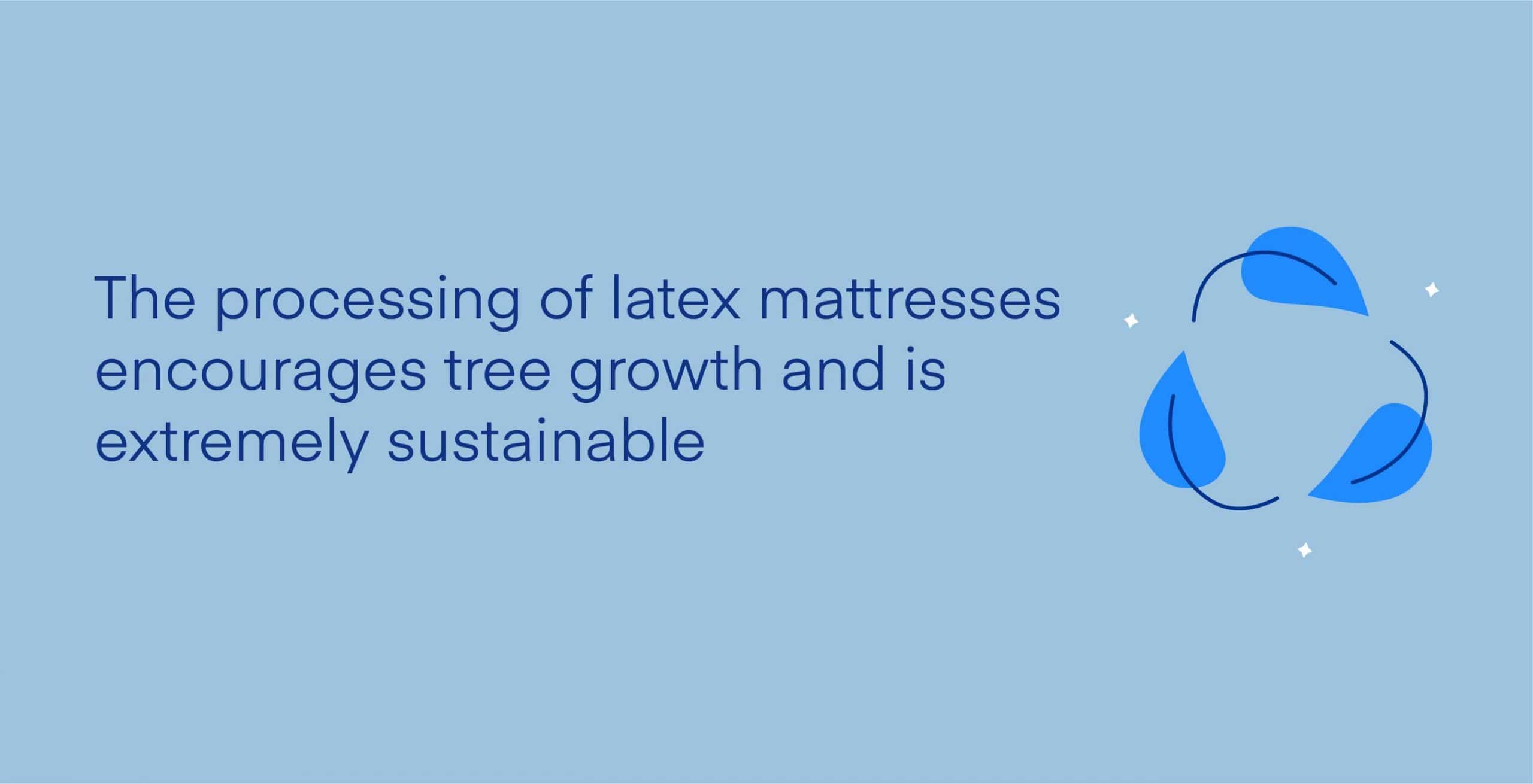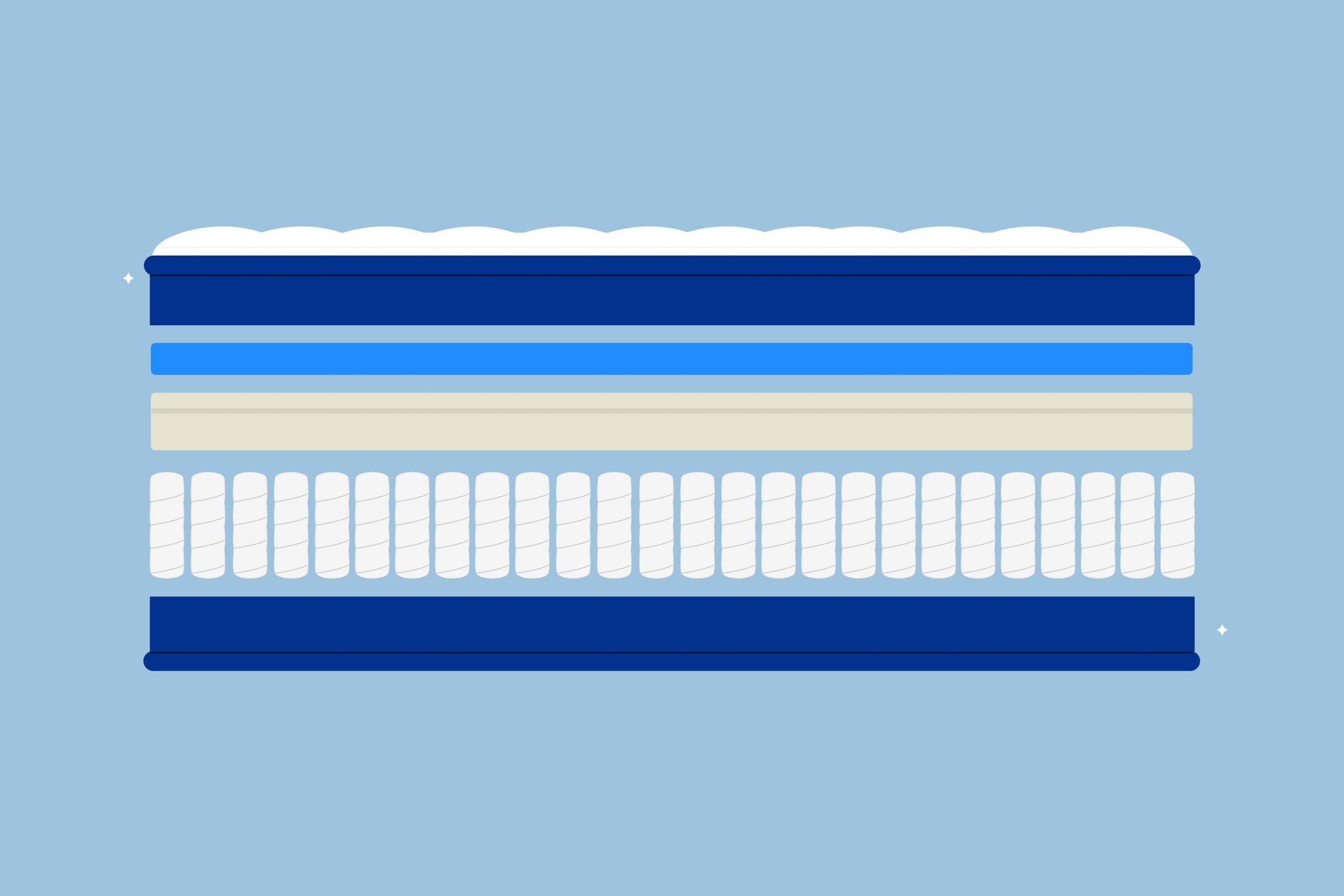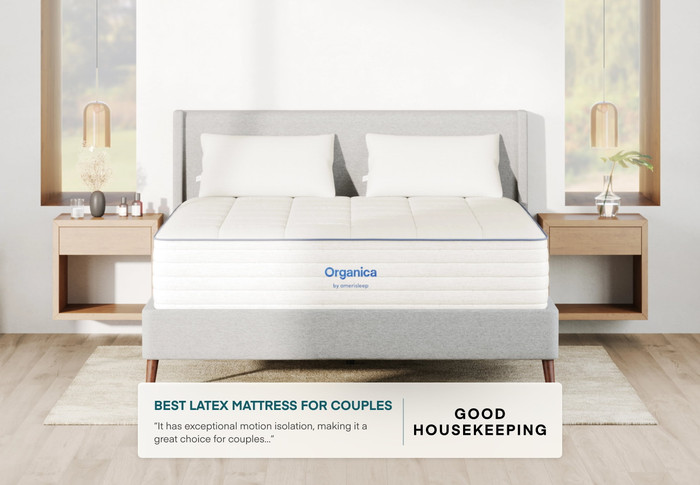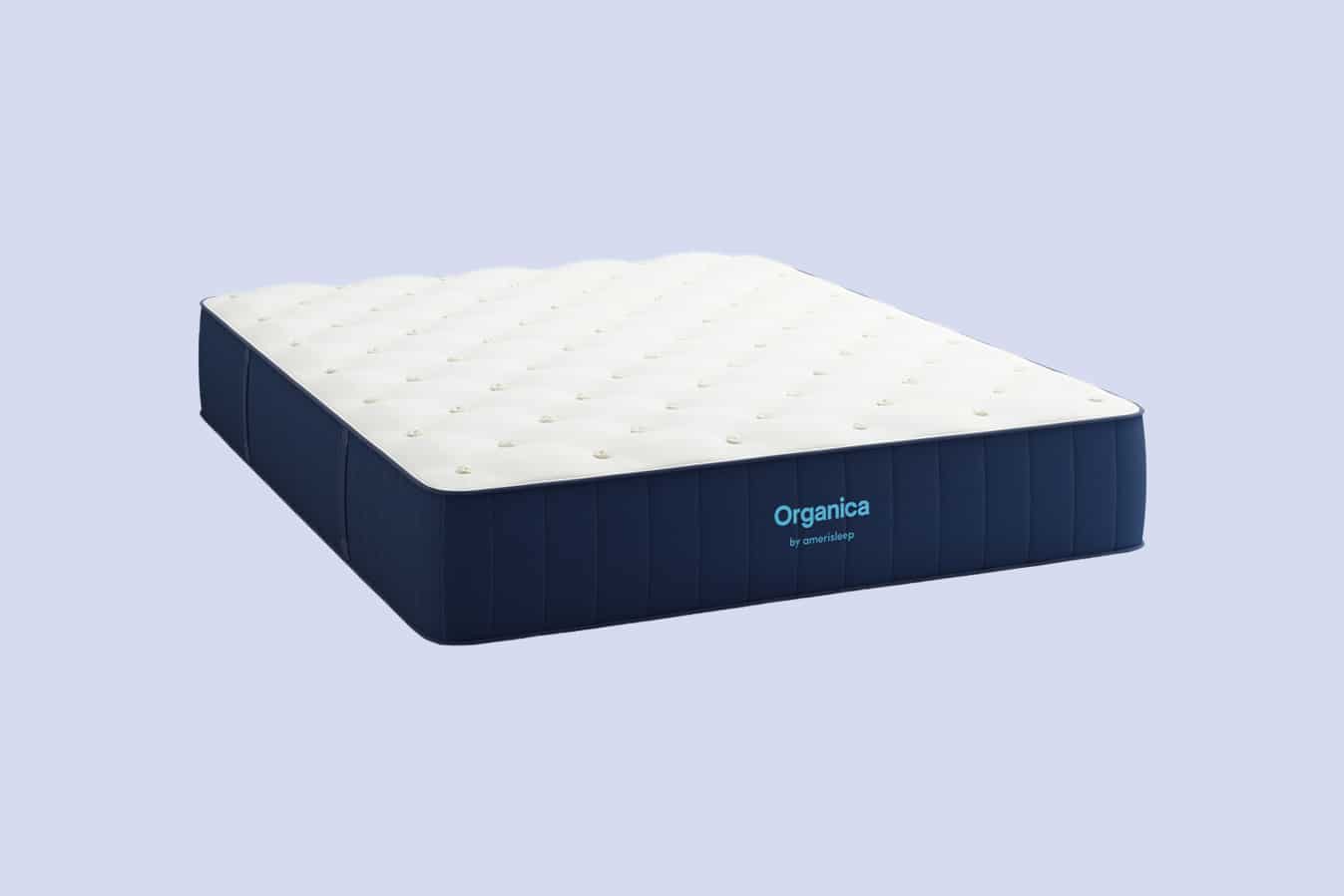Key Takeaways
- Types of Latex Foam: Latex mattresses are available in three types: synthetic, blended, and natural. Natural latex, harvested from rubber trees, is the most eco-friendly and durable option. It offers benefits like pain relief, hypoallergenic properties, eco-friendliness, breathability, and durability.
- Types of Natural Latex Foam: Natural latex mattresses are divided into two categories based on their production methods: Dunlop and Talalay. Dunlop latex is uniform in density, entirely natural, and more affordable, while Talalay latex is softer, bouncier, but may contain synthetic foam, making it less than 100% natural.
- Certifications to Watch For: When choosing a latex mattress, consider third-party certifications like GOLS, GOTS, eco-INSTITUT, GREENGUARD Gold, and OEKO-TEX Standard 100 to ensure the mattress meets eco-friendly and safety standards.
Latex mattresses are increasingly popular for their extreme comfort and durability. They are also associated with eco-friendly practices and enhanced sleep health. However, not all latex mattresses carry these benefits. So how do you choose the best latex mattress for you, or know if a latex mattress is right for you at all?
In this article, we will define what a latex mattress is, go over the different types of latex mattresses, and discuss how they provide a good night’s sleep.
What Is a Latex Mattress?
A latex mattress is constructed from two to four layers of latex foam, and there are three different types of latex foam: synthetic, blended, and natural.
Synthetic latex mattresses are primarily crafted from a rubber-mimicking plastic called styrene-butadiene rubber (SBR). SBR is also used in artificial turfs, tires, and conveyor belts. Latex mattresses with SBR are safe and an affordable alternative to natural latex but not nearly as durable. Additionally, off-gassing chemicals irritating to people with respiratory issues are prevalent in synthetic latex.
Blended latex mattresses contain less toxic chemicals. These types of beds are 30 percent natural latex and 70 percent synthetic latex. Blended mattresses last longer than synthetic latex, but not natural latex.
Natural latex is more supportive, durable, eco-friendly, and better for sleep health than synthetic and blended latex. It is harvested and refined from the milk-like sap of a rubber tree called Hevea Brasiliensis. This process encourages the healthy growth of rubber trees as they can be tapped for up to 30 years. Once the sap is harvested, it is processed into Dunlop or Talalay foam; both are soft, supportive, and extremely durable. We will discuss the differences between Dunlop and Talalay later. First, let’s dive deeper into the benefits of a natural latex bed.
Five Benefits of a Natural Latex Mattress
Natural latex beds are preferable to synthetic and blended latex for their eco-friendliness, durability, and health benefits.
1. Pain Relieving
The gentle cushioning and buoyant support of latex foam mattresses are especially beneficial for sleepers with back and joint pain.
Latex foam softly cradles heavy body parts, such as the hips and shoulders. This light contouring provides pressure relief near the joints and lower back, while latex’s natural elasticity maintains natural spinal alignment by gently supporting lighter areas, like the neck and back.
2. Hypoallergenic and Low Maintenance
If a bed is not continually cleaned, microorganisms, such as bacteria, fungi, and viruses can easily collect on the top of the mattress and cause mold and mildew to grow and dust mites to accumulate. This results in bedroom allergies and an unsafe sleeping environment.
However, latex is naturally antimicrobial, meaning it repels harmful microorganisms, making latex an excellent choice for people with year-round allergies or anyone too tight on time to sanitize their mattress. It’s still important to understand the disadvantages of sleeping on old mattresses, but latex beds are one of the best types for bed longevity.
3. Eco-Friendly
As mentioned above, natural latex is refined from the sap of the rubber tree. The trees are not cut down or damaged during this process and can produce sap for up to 30 years. Therefore, the processing of latex mattresses encourages tree growth and is extremely sustainable. Natural latex is also biodegradable, ensuring it won’t sit in a landfill for years.

Although harvesting latex is a sustainable process, latex mattresses are not always manufactured responsibly. Some manufacturers use chemicals harmful to our health and environment. A GREENGUARD Gold, OEKO-TEX Standard 100, eco-INSTITUT, or GOLS certification will guarantee the mattress is primarily composed of natural materials and safe for use. We will further discuss these certifications later.
Latex mattresses may also contain other natural materials that can help a person with synthetic sensitivities sleep well at night. Similarly, they can be one of the best mattresses without fiberglass if the manufacturer uses wool, plant fibers, or silica as a fire barrier.
That’s not to say that all non-latex mattresses automatically have fiberglass. You can find a memory foam mattress without fiberglass, too, often far more cheaply than what a latex mattress costs.
See our guide to why you can benefit from a fiberglass-free mattress.
4. Breathable
Natural latex foam has an open-cell structure to permit constant airflow. The foam layers are also constructed with pinholes, enhancing breathability. Most importantly, chemicals found in synthetic materials retain body heat and natural latex mattresses contain little to no additives.
If you want an especially cool mattress, opt for a breathable cover made from cotton or wool.
5. Durable
Natural latex mattresses are best known for their long-term comfort. High-quality latex mattresses have an average lifespan of 12 to 20 years—significantly longer than other types of mattresses. The resiliency of natural rubber is often credited for this longevity. A natural latex mattress effortlessly bounces back once the pressure is removed, maintaining its original shape over years of use.
Types of Natural Latex
As previously mentioned, natural latex is processed using one of two methods: The Dunlop or Talalay Method. Both methods include tapping or slitting the bark of a rubber tree to collect sap. After collecting an appropriate amount of rubber tree sap, it is whipped into foam and prepared for the Dunlop or Talalay process.
Dunlop Latex
Dunlop latex is made by pouring the foam into a mold then heating it up in an oven to harden. After hardening, the latex is removed from the mold and washed. This frees it from any remaining debris and prolongs its life without compromising elasticity. Once washed, the foam is dried. Dunlop latex is uniform in density, entirely natural, and more affordable than Talalay latex. It is also older and more eco-friendly.
Talalay Latex
The Talalay method requires more time and energy, resulting in a higher price point than Dunlop latex.
First, the foam is poured into a mold. However, unlike the Dunlop method, the mold is only filled halfway. It is then sealed and vacuum is used to expand the latex until it completely fills the mold. After the mold is filled, it is placed in a freezer and carbon dioxide is injected into the rubber to create a gel-like texture. The gel-like foam is then hardened with heat, removed from the mold, washed, and dried. Finished Talalay Latex is softer and bouncier than Dunlop.
However, manufacturers create a softer feel of Talalay by using synthetic foam. Therefore, Talalay is not 100% natural like Dunlop.
Certifications
If you are concerned about the eco-friendliness of your mattress, consider purchasing one backed by the following third-party certifications.
Global Organic Latex Standard (GOLS)
The Global Organic Latex Standard ensures latex mattresses are made from at least 95 percent organic latex and free from toxic chemicals, like chlorine bleach, GMOs, synthetic sizing substances, carcinogenic azo dye, and more.
Certified brands are required to meet stringent requirements during the harvesting, manufacturing, packaging, labeling, and distribution of their organic latex mattresses to maintain sustainability. GOLS also guarantees fair labor practices. A product with this label must be GOTS or Eco-INSTITUT certified as well.
Global Organic Textile Standard (GOTS)
The Global Organic Textile Standard monitors naturally grown textiles all the way from the plantation to the shelf. This certification guarantees any natural wool or cotton covers on a latex mattress are organic as well. There are two levels to the GOTS label: made with organic and organic.
Textiles labeled as “made with organic” must contain at least 70 percent organic material while textiles labeled as “organic” must contain 95 percent or more organic fibers. Similar to GOLS, this label curbs the use of harmful chemicals.
eco-INSTITUT
Eco-INSTITUT certified products are tested for volatile organic compounds (VOCs) like formaldehyde, heavy metals, toxic fire retardants, and other pollutants. This label certifies a product has little to no emission levels and is safe for in-home use.
GREENGUARD Gold
GREENGUARD Gold is primarily concerned with keeping vulnerable populations, such as children and the elderly, safe. Like eco-INSTITUT, this label guarantees low emission levels and little to no volatile organic compounds.
OEKO-TEX Standard 100
OEKO-TEX Standard 100 certified products undergo over 100 test parameters to verify they do not contain harsh chemicals. The standard tests every inch of textile products for non-regulated azo dye, nickel, GMOs, and more. Textile products are also tested for substances not harmful by law but disadvantageous to human health.
Consider Our Latex Hybrid Mattress
Quick Guide: A 30-Second Summary
| Best Latex Mattress | Amerisleep Organica |
-
Price Range
$1199 to $2698
-
Mattress Type
Latex Hybrid
-
Firmness
5 to 6 out of 10 (Medium)
-
Availability
All sizes
-
Warranty
20 Years
-
Thickness
13 Inches
Our latex mattress, Organica, combines a top of Talalay latex and cushioning wool with a base of pocketed coils. All of which is wrapped in a breathable and cooling organic cotton cover.
- Contains a Talalay latex comfort layer and a Dunlop latex base
- Pocketed coils add to bed’s bounce and flexibility
- Natural wool is a sustainably-sourced flame barrier
- Eco-conscious shoppers
- Most sleeping positions
- Couples
- Hot sleepers
We focus on using eco-friendly, durable materials in all of our mattresses, but the Amerisleep Organica is easily our best when it comes to a natural bed. It features a list of certifications for the mattress’s cotton, wool, and Talalay latex, all of which is supported by a pocketed coil layer and a Dunlop latex base. The medium feel is perfect for back, side, and combination sleepers.
The top layer is Joma wool to cushion the sleeper’s body, while the underlying Talalay latex helps the mattress contour to the sleeper for pressure relief and support. Both wool and Talalay latex are breathable materials, staying cool throughout the night.
The coil support system inside this hybrid mattress has every spring individually wrapped for independent reaction. In other words, the wrappings help the mattress isolate movement, keeping your body’s slightest twitch from transferring across the Organica’s surface. The Dunlop latex base helps the coils stay upright, structuring the overall mattress.
A breathable cotton cover encases the entire bed. Cotton lets air circulate through the mattress while wicking away heat and moisture.
The independent organizations that have certified our mattress are:
- The Global Organic Textile Standard monitored the process behind the mattress’s yarn.
- The wool and Talalay latex have passed the OEKO-TEX Standard 100’s test.
- The Rainforest Alliance has certified the Talalay latex as a product made by farmers, foresters, and companies looking to minimize the impact on nature.
- The eco-INSTITUT has tested the VOCs emission levels of the Talalay latex.
The Organica includes free shipping, a 100-night trial, and a 20-year warranty, same as every other Amerisleep mattress.
FAQs
What are the cons of latex mattresses?
Heaviness is a commonly reported drawback of latex mattresses. Natural latex is denser than most materials and thus, heavier. A queen latex mattress can weigh up to 130 pounds, making it difficult to flip or rotate alone.
Natural latex mattresses are also higher priced because they are made from expensive materials. Although the price varies from brand to brand, a queen size latex bed can cost up to $3000. For some, a latex free mattress may be what they need to sleep well without breaking the bank.
Are latex mattresses better than memory foam mattresses?
Both latex and memory foam are popular mattress types but designed to meet the needs of different sleepers. Memory foam mattresses are better at cushioning and relieving high-pressure areas, making them excellent mattresses for back pain relief. Latex contours closely but is naturally bouncy and firmer than memory foam. This combination aligns the spine while gently providing pressure relief and is a good option for heavier sleepers or people with pain points.
Can someone with a latex allergy sleep on a latex mattress?
Natural latex mattresses are considered safe for people with a latex allergy. Latex allergies arise after direct exposure to proteins found in natural latex products, such as balloons and gloves. However, a latex mattress is washed repeatedly during the manufacturing process, significantly reducing allergy-causing proteins. Additionally, bedsheets minimize direct contact with the mattress.
All of that said—and although some may consider it relativity safe—we do not recommend sleepers with latex allergies choose a latex bed. If you have your eye on one of these mattresses, consider consulting with your doctor about your latex allergy before sleeping on a latex bed.
Do natural latex mattresses smell?
Natural latex mattresses do not off-gas but may smell similar to rubber. However, the washing involved in the manufacturing process weakens this odor. Most consumers describe the smell of natural latex as subtle, sweet, and sometimes vanilla-like.
What is the best foundation for a latex bed?
Latex beds require a slatted, solid wood, or solid steel foundation. These uniform bases prevent premature sagging and soft spots by providing a sturdy bottom for the foam to rest on top of. Since latex is flexible, most latex mattresses are also compatible with adjustable bed frames. Avoid box springs as the bouncy coils will wear out the foam layers and potentially deplete support.
Do latex mattresses isolate motion?
Latex mattresses isolate motion better than innerspring mattresses, but not as well as memory foam mattresses do. Innerspring beds have springy coil support cores that move in tandem and easily transfer motion.
Memory foam, on the other hand, is extremely responsive and suppresses motion transfer by absorbing movement. Latex mattresses are also responsive, but naturally elastic. Any time pressure is removed, the foam immediately bounces back, potentially jostling your sleep partner.
Conclusion
The unique feel of a latex mattress can provide a restful night’s sleep. Although expensive, natural latex is constructed from durable materials and maintains quality after years of use. Beds with natural latex are typically eco-friendly mattresses, and they’re also sustainable and easier to care for, as well. And if you need a mattress without memory foam for health reasons, latex foam is often the best choice.
If you are considering a latex mattress because it’s a more organic choice, remember to pick an all-natural latex bed or search for labels proving its eco-friendliness.
About the author
Sanchita Sen is a full-time writer focusing on the sleep health and mattress industry. She is a former journalist who has written numerous articles on the healthcare sector. Some of the topics she has covered include how to lucid dream, fever dreams, melatonin for sleep, and best gel memory foam mattress. Sanchita holds a Master of Arts in Communications from Convergence Institute of Mass Media and Information Technology Studies. She is also a published author, who seeks inspiration from both real life and the world of fiction.
View all posts






